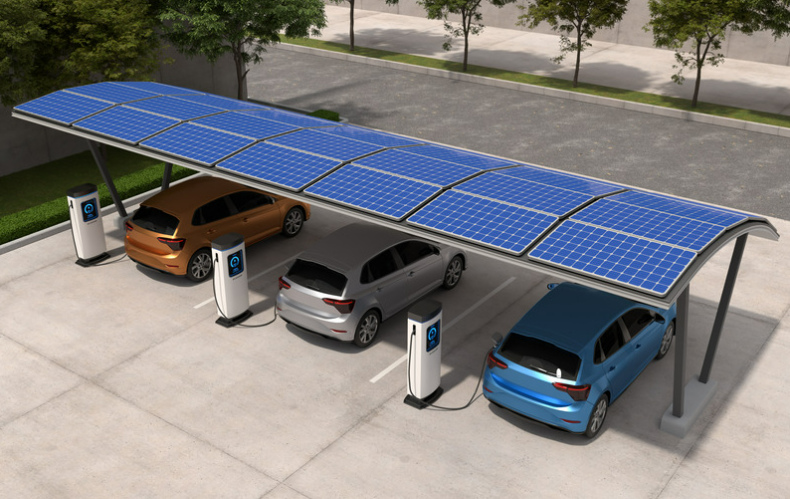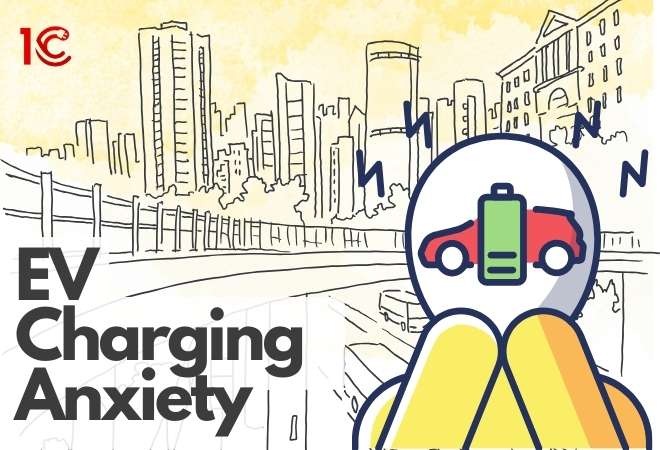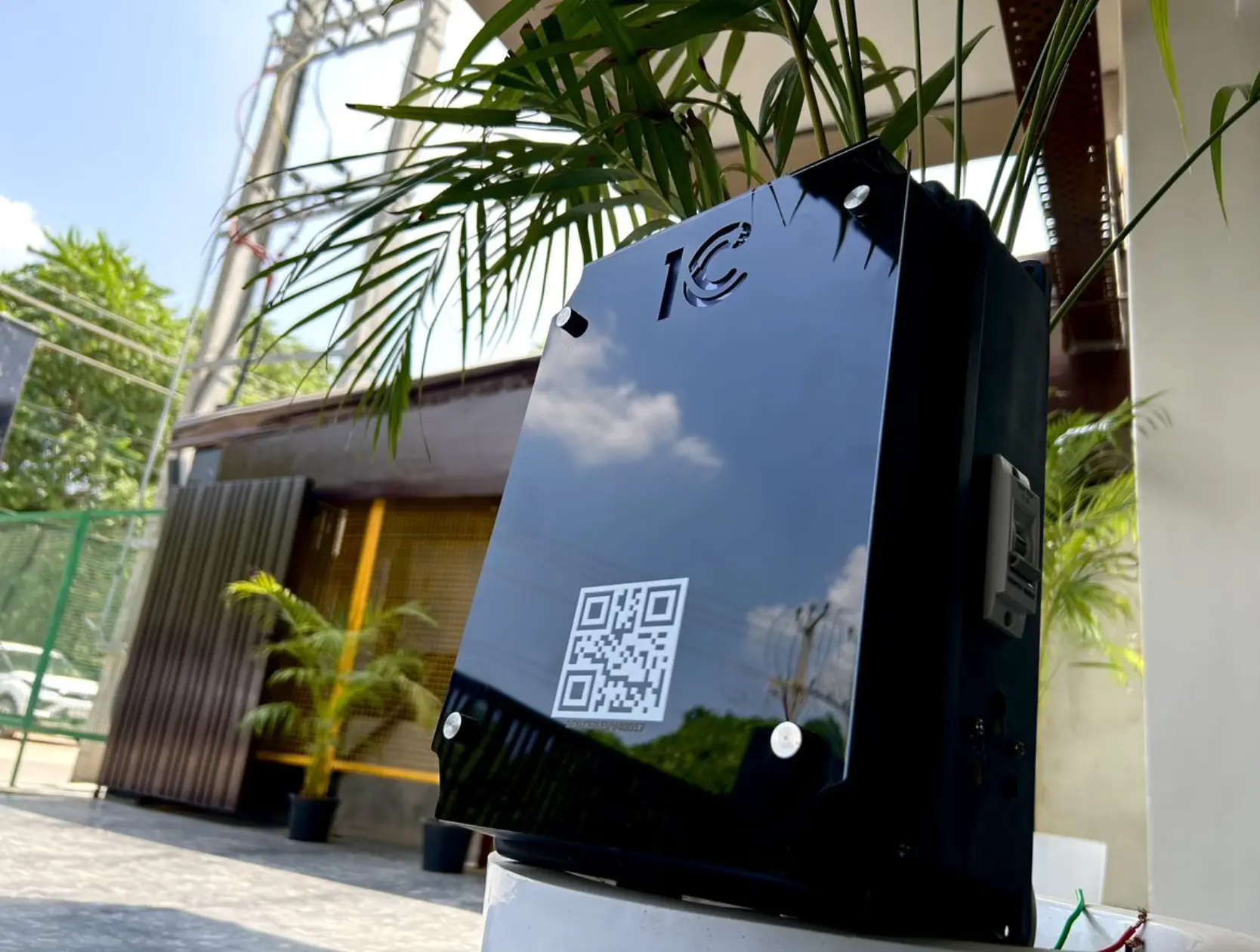
What is Solar EV Charging?
EV charging stations serve as the link between the renewable energy generated by residential solar panels and the electricity used to recharge EV batteries.
Common interactions between charging stations and solar systems include:
- Offsetting grid electricity consumption with solar energy production, reducing reliance on non-renewable sources.
- Drawing solar-generated electricity from the grid supplied by utility companies specializing in 100% renewable energy.
- Using solar-generated electricity stored in household battery storage units charged by solar panels.
- Charging vehicles with optimized settings for solar energy usage through smart charging features.
- Optimizing solar settings for multiple household appliances and EV charging via an energy management system.
However, the situation is more nuanced than with internal combustion engine vehicles. Here are several key points to understand about EV batteries and how to handle them if they deplete.
What is Solar EV Charging?
Solar EV charging is a method of recharging electric vehicles using energy from the sun. It involves installing solar panels, which harness sunlight and convert it into electricity to power EVs. This sustainable approach reduces reliance on traditional grid electricity and offers an eco-friendly way to fuel electric vehicles.
Components of Solar EV Charging
Solar EV charging systems comprise three primary components:
- Solar Panels: These are installed on rooftops or elsewhere on the property to capture sunlight and convert it into electricity.
- Inverters and Charge Controllers: Inverters convert the solar DC electricity into usable AC electricity for the home and EV charging station, while charge controllers regulate the electricity flow from the panels to prevent overloading.
- EV Charging Station: This station allows you to recharge your electric car’s battery using the solar-generated electricity.
Instead, when an EV’s battery is depleted, the vehicle typically enters a low-power mode or comes to a complete stop. In such cases, roadside assistance or a tow to a charging station is necessary to recharge the EV’s battery. Once at a charging station, the EV can be plugged in to recharge its battery to resume normal operation. It’s essential for EV owners to plan their trips carefully and monitor battery levels to avoid running out of power while driving.

Additional components may include battery storage units for storing surplus solar electricity and maximizing usage outside of sunlight hours. Various types of solar panels exist, including polycrystalline and monocrystalline panels, each with its own efficiency and cost considerations. Inverters can be string or microinverters, with microinverters offering higher efficiency but at a higher cost. Charge controllers, such as MPPT controllers, optimize electricity production by regulating the flow of electricity from the panels to the home and EV charging system.
Planning to set up a Charging station?
Connect with 1C for expert advice on EV chargers
Process of Charging EVs with Solar Panels
Charging electric vehicles with solar panels involves several steps. Firstly, solar panels harness sunlight and convert it into DC power using photovoltaic cells. This DC power is then converted into AC power for immediate use or storage in a power bank. By storing solar power, the system ensures consistent energy availability, during periods of varying solar intensity or high demand. Networked solutions, such as those provided by EV Connect, manage technical aspects through a centralized portal, optimizing efficiency and convenience for EV owners.
Read More:
Types and Speeds of Solar EV Charging Stations
There are two primary types of solar EV charging stations: Level 1 and Level 2.
Level 1 Solar EV Charging:
- In Level 1 charging, EVs are plugged directly into the home’s electrical system via a standard plug socket.
- This method relies on household electricity supply, supplemented by solar energy from installed panels when available.
- Level 1 charging is slower compared to Level 2, making it less suitable for daily charging needs.
Level 2 Solar EV Charging:
- Level 2 charging involves using a dedicated home EV charging station,
- installed in the garage or preferred outdoor parking area.
- These chargers provide electricity to the vehicle at the optimal voltage and power required, making them faster than Level 1 charging.
- Similar to Level 1, Level 2 chargers interact with solar electricity, using it if available.
While Level 1 and Level 2 charging stations do not inherently offer solar optimization options, they provide a holistic overview of how solar charging works in principle.
Read More:
Types of Solar Panels for Home EV Charging
Various types of solar panels are available for home EV charging systems, catering to different needs and preferences. The primary types include:
- Polycrystalline Panels: These are the most common and cost-effective solar panels, using polycrystalline silicon as a semiconductor. Although less efficient than monocrystalline panels, they offer affordability.
- Monocrystalline Panels: The second most prevalent type, monocrystalline panels use monocrystalline silicon. While more expensive than polycrystalline panels, they are more efficient and capable of generating higher electricity output.
Other types of solar panels, though less common for home EV charging, include:
- Thin Film or Flexible Panels: These are suitable for installation in unconventional locations like houseboats due to their flexibility.
- Bifacial Solar Panels: Semi-transparent panels that allow light to pass through, reflecting and absorbing it from both sides.
- Solar Shingles, Tiles, or Roofs: Innovative technology that integrates solar panels into roofing materials, offering aesthetic appeal and long-term durability, albeit at a higher cost.
Each type of solar panel has its own advantages and considerations, providing options for homeowners seeking to integrate solar power into their EV charging setup.
Conclusion
In conclusion, Solar EV charging integrates sustainable energy to power electric vehicles, offering an eco-friendly alternative. With diverse solar panel options and charging station types, it marks a significant stride toward greener and efficient transportation. The evolving technology addresses concerns, making solar-powered EVs a viable and responsible choice for the future. Embracing solar energy not only benefits individual users but contributes to a cleaner and more sustainable energy landscape.
FAQs
1. Can you charge EV with solar?
Charging an electric car battery with solar power is entirely feasible. If you already have solar panels in place, it’s akin to leveraging the sun’s energy for various household needs, including charging electronic devices and powering appliances like refrigerators and televisions.
2. What is solar powered EV charging station?
A solar charging station is a special service station designed for recharging electric vehicles. What sets it apart is its reliance on 100% renewable energy. This is made possible through a photovoltaic energy generation infrastructure and a battery energy storage system. These stations provide the essential power for ultra-fast recharging of electric vehicles that require it.
3. क्या आप ईवी को सोलर से चार्ज कर सकते हैं?
हां, आप पूरी तरह से सोलर ऊर्जा का उपयोग करके ईवी को चार्ज कर सकते हैं। जो लोग पहले से ही सोलर पैनल स्थापित कर चुके हैं, उन्हें यह दृष्टिकोण विचार करना चाहिए: आप पहले से ही सूर्य की ऊर्जा का उपयोग कर अपने फोन और उपकरणों को चार्ज कर रहे हैं और फ्रिज और टेलीविजन जैसे उपकरणों को चला रहे हैं।








